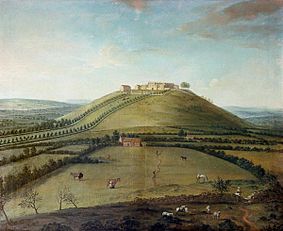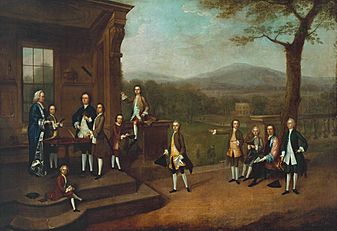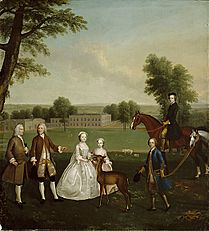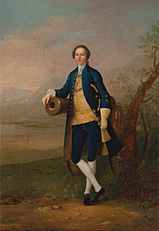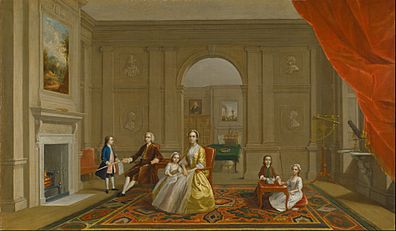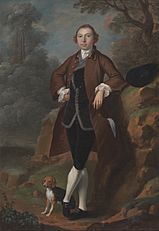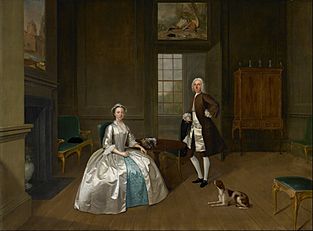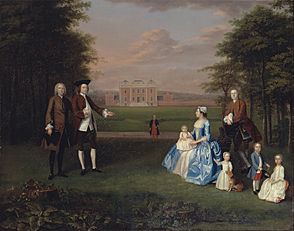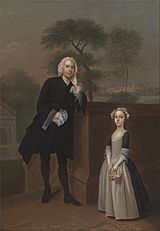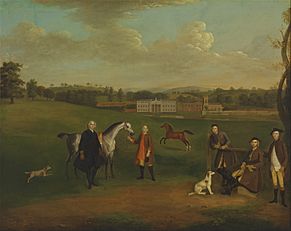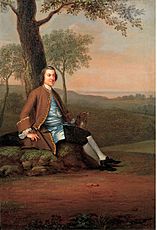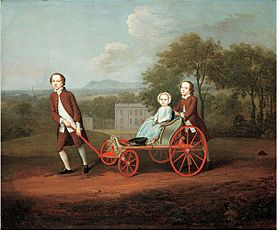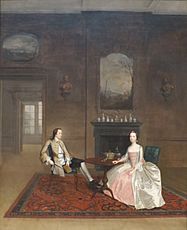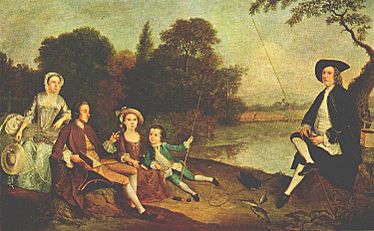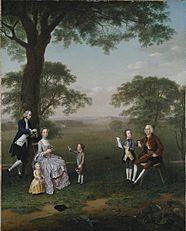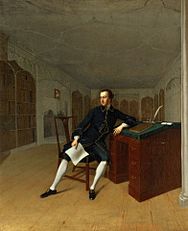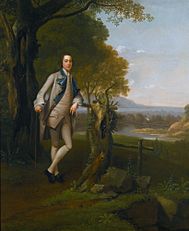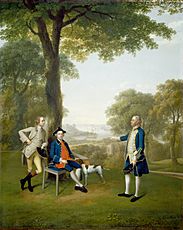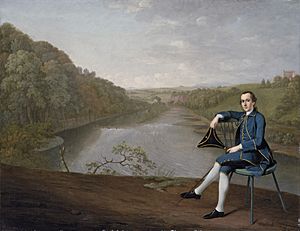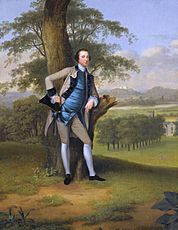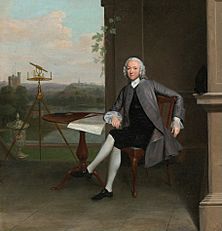Arthur Devis facts for kids
Arthur Devis (born February 19, 1712 – died July 25, 1787) was an English artist. His father, Anthony, started a family of painters and writers. Arthur Devis is best known for painting a type of portrait called a conversation piece. These paintings show groups of people, often families or friends, in a natural setting, like a room or a garden.
Devis moved to London and learned from a Flemish artist who painted landscapes. Later, he started painting portraits and became quite famous. However, his success did not last. He found it hard to change his style to fit new art trends. Because of this, he got fewer jobs, and his work was mostly forgotten after he died. But in the 1900s, people became interested in conversation pieces again, and Arthur Devis's art became popular once more.
Contents
Who Was Arthur Devis?
Arthur Devis was born in Preston, Lancashire. He was the oldest son of Anthony Devis, who was a carpenter and bookseller. His father might have introduced him to a Flemish painter named Peter Tillemans, who became Arthur's teacher.
How Did Devis Start His Art Career?
In the early 1730s, Devis worked as an assistant in Tillemans's studio in London. He copied paintings of Italian scenes by famous artists like Pannini. His first paid painting was a landscape showing a house and its park. This showed his early interest in painting outdoor scenes.
By 1737, Devis had become a portrait painter. In 1745, he opened his own studio in London. By this time, he was quite well-known for his art.
Did Devis Have Any Famous Connections?
Devis often painted people from important families in Lancashire who supported the Jacobite cause. The Jacobites wanted to bring back the old royal family to the throne.
There's a story that Devis looked so much like the 'young pretender' (Prince Charles Edward Stuart, a Jacobite leader) that he was once arrested! This story was even written down in a book about painters and later in a play.
Why Did His Popularity Change?
Devis worked very hard and got many portrait jobs between 1748 and 1758. But he didn't keep up with the new styles of artists like Joshua Reynolds. People started to think his paintings looked old-fashioned.
For example, in 1765, a nobleman named Lord John Cavendish said that Devis's pictures were "all of a sort." He meant they always showed people in similar poses, like leaning against a pillar or standing by a flower pot.
What Did Devis Do Later in Life?
Even though his fame faded, Devis became president of the Free Society of Artists in 1768. He also showed his paintings there. However, he was never asked to join the more famous Royal Academy.
To earn money, he started restoring old paintings. This could be very profitable. He worked on family portraits for Sir Roger Newdigate and even restored a large painted hall at the Royal Naval Hospital in Greenwich, earning a lot of money for it.
In 1783, Devis sold all his paintings. He died in 1787 in Brighton and was buried in London.
What Are Devis's Paintings Like?
In the 1900s, when conversation pieces became popular again, people called Devis "the tireless Devis" because he painted so many. One expert, Ellen Gates D'Oench, found that he painted more than twice as many pictures as people first thought!
How Did His Style Develop?
Because of his early training, Devis's first paintings were wide landscapes with tiny figures. An example is his painting of Hoghton Tower (1735). He later used this style to paint the backgrounds of mansions and gardens for people who ordered portraits of themselves and their families.
By the 1750s, his paintings focused more on a main person, often leaning gracefully against a tree. Sometimes, buildings would be small details in the distance.
Did Devis Paint Exactly What He Saw?
It's been said that Devis's paintings often show "a magical world of make-believe." He painted people and their surroundings not exactly as they were, but as they wished them to be.
For example, his painting of Okeover Hall doesn't show the house as it was actually built. Devis used a different design that the owner had considered. The people in the painting look like they were painted in his studio, not at the actual building site. If he had visited, he would have seen that the house was being built differently and that there were no workers, which was a different reality than the perfect scene he painted.
Another example is "Edward Rookes-Leeds and his Family" (around 1763-8). The beautiful countryside in the background hides the fact that the family's money came from industrial factories on their land.
Were His Interiors Real?
Devis often created impressive indoor scenes using ideas from architecture books, rather than painting real rooms. One special case is the library at Arbury Hall in his portrait of Roger Newdigate (1756-8). Newdigate is holding the actual plan for the room.
However, "Breaking-up Day at John Clayton's School in Salford" (1738-40) is a fantasy. The building in the painting looks grand, but the real school was made of brick, not stone. It seems that Devis sometimes had paintings of figures in these fancy rooms ready in his studio. He would then just add the faces of his clients, charging more for extra details like a fancy carpet.
Why Do the Figures Look "Doll-like"?
People often say the figures in Devis's paintings look like dolls. This is because, like other artists of his time, Devis used special wooden figures called mannequins. These figures had movable joints and could be dressed in the latest fashions. Artists would pose them to save their clients the trouble of coming to the studio often. These poses often followed rules from books about polite behavior.
What Messages Did His Paintings Send?
By looking closely at Devis's paintings, we can understand the messages his clients wanted to share about themselves. For example, "A Gentleman and Lady at the Harpsichord" (1749) shows a couple playing music. This suggests they have a happy marriage. But it also shows who is in charge: the man hands the woman the music, and she will play the harpsichord while he plays the violin. She is sitting, and he is standing closer to the window, which also hints at his higher status.
The painting also shows the man's wealth. The light comes from a stylish three-sectioned window, which was very fashionable then. Their interest in music also shows they were cultured. In other paintings, a globe or scientific tools show that the people were learned and interested in science.
Gallery
-
Mr. and Mrs. Richard Bull (1747)
-
Sir Joshua Vanneck, 1st Baronet and Family at Roehampton House, Putney (1752)
-
Sir Roger Newdigate in his Gothic Revival Library at Arbury Hall (1756-1758)
-
Philip Howard of Corby Castle, Cumberland (1759)
Devis's Family and Legacy
Arthur Devis married Elizabeth Faulkner in London on July 20, 1742. They had twenty-two children, but only six lived past infancy.
Were Any of His Children Artists?
Yes! Two of his sons, Thomas Anthony Devis (1757–1810) and Arthur William Devis, became painters. One daughter, Ellin Devis, became a schoolmistress and wrote a popular grammar book called The Accidence (1775).
Arthur's half-brother, Anthony Devis, was also a painter. And his son-in-law, Robert Marris, who married Arthur's daughter Frances, was also an artist. This shows how art ran in the family!
The family's creative tradition continued for many years. For example, the poet Martin Farquhar Tupper was a descendant, and his daughters later published a book of poems. One of them, Ellin Isabelle, even wrote a book about the family's history.
See also
 In Spanish: Arthur Devis para niños
In Spanish: Arthur Devis para niños




